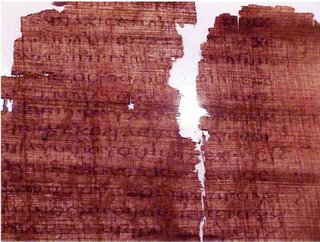
Recently, National Geographic along with Coptic linguists and biblical scholars have announced the finding of what they call the “Gospel of Judas” or Peuaggelion Nioudas. This writing was found to be an ancient Egyptian Coptic text. Samples of the papyrus were analyzed at the University of Arizona's radiocarbon dating lab in Tucson—the world-renowned facility that was responsible for dating the Dead Sea Scrolls. The dating found is confidently placed at 220-340 A.D. Other linguist working on the text, because of theological nuancs, suggest a later date--possibly 400 A.D. The gospel of Judas, so called, is a codex—a method of keeping manuscripts beyond the use of scrolls. The older method of scrolls often made difficult the finding of a certain passage. The codex method allowed the pages to be placed sequentially and bound like a book.
The term “gospel” describes the genre of the type of manuscript that the writing of Judas is from. However, “gospel” comes from the Greek word for “good news”, thus, beyond genre, this author does not view this writing of Judas as “good news” since it distorts the orthodox Christian views of Jesus Christ. The “gospel of Judas” will be called the writing of Judas or etc. The term “gospel” will not be used in conjunction herein.
First, the way the media presents this writing it would seem it is a new discovery. It is heraleded as a great new find.
Christianity Today (June 2006) offers these salient comments that are more revealing, "the best liberal scholars admitted up front that this find "tells us nothing about the historical Jesus, nothing about the historical Judas." Those are the words of James M. Robinson, lead scholar of the team that investigated the last great find of Gnostic Gospels, the Nag Hammadi library. Or as Adam Gopnik told New Yorker readers, "The finding of the new Gospel … no more challenges the basis of the church's faith than the discovery of a document from the nineteenth century written in Ohio and defending King George would be a challenge to the basis of American democracy."
The codex was discovered in the Egyptian desert in the 1970’s. It finally reached the United States and rested unfavorably in a safety deposit box for 16 years. Sadly, the writing of Judas deteriorated tremendously in the decades after its discovery. The codex was broken into many fragments and even crumbled at even the slightest touch. The sheets of the codex had also been reshuffled in a random pattern—most likely to increase the appeal to potential buyers by moving pages in apparently better physical condition to the front of the codex. Thus, the original pagination was lost; this complicated things tremendously especially in efforts to reassemble the manuscript. Conservationists, aided by computer software, were able to reconstruct most of the manuscript, fragment by fragment, over a period of five years. Consequently, the linguists in review of this codex have been able to translate the text. An English and Coptic translation can be downloaded here:
http://www9.nationalgeographic.com/lostgospel/document.htmlSecond, the writing of Judas begins in esoteric fashion, “The secret account of the revelation that Jesus spoke in conversation with Judas Iscariot during a week three days before he celebrated Passover.”
This intro gives the text away immediately as an Gnostic writing and non-Christian. Considering the dating of this codex we should feel compelled to, at least, consider the implications of competing doctrines—specifically Gnosticism—a belief contemporary with the early church and this codex. The Gnostics obviously wished to paint the life of Jesus with a different brush. Gnosticism is a heretical movement in the early Christian centuries that emphasized salvation through a secret gnosis or knowledge.
[1] Given the opening of this codex, e.g. "secret...revelation", it is apparently an Gnostic theological teaching.
These Gnostic type manuscripts are not new, neither are such methods. Such writings were expressly for rewriting the normative and accepted biblical accounts. (Odd, I think somebody named Dan Brown wrote something like that too.) Manuscripts such as these were around in 180 A.D. We know this because a historic early church leader by the name of Irenaeus wrote about it in his work entitled
Against Heresies. Such sects are called Cainite Gnostics, in fact the Ante-Nicene Fathers rebut them often. This is an early group that repeatedly tried to rewrite the orthodox biblical stories and spin them to give positive reflections of biblical characters seen as negative or evil in the Bible, including Cain and the Sodomites.
The writings of Judas indicate numerous theological concepts held by Gnosticism existing in the 2nd Century. Forms of Gnosticism were taken up with subdeities like angels and demiurges. For example in Scene 3 of the text, under “JESUS TEACHES JUDAS ABOUT COSMOLOGY: THE SPIRIT AND THE SELF-GENERATED” it is recorded:
Begin quote:
Jesus said, “[Come], that I may teach you about [secrets] no person [has] ever seen. For there exists a great and boundless realm, whose extent no generation of angels has seen, [in which] there is [a] great invisible [Spirit], which no eye of an angel has ever seen,no thought of the heart has ever comprehended,and it was never called by any name. “And a luminous cloud appeared there. He said, ‘Let an angel come into being as my attendant.’ “A great angel, the enlightened divine Self-Generated, emerged from the cloud. Because of him, four other angels came into being from another cloud, and they became attendants for the angelic Self-Generated. The Self-Generated said, [48] ‘Let […] come into being […],’ and it came into being […]. And he [created] the first luminary to reign over him. He said, ‘Let angels come into being to serve [him],’ and myriads without number came into being. He said, ‘[Let] an enlightened aeon come into being,’ and he came into being. He created the second luminary [to] reign over him, together with myriads of angels without number, to offer service. That is how he created the rest of the enlightened aeons. He made them reign over them, and he created for them myriads of angels without number, to assist them.
End quote.
This writing of Judas also purports that Christ persuades Judas to betray Him. This view implies more of a human effort in the Christian plan of redemption rather than a divine one. Recent writings have attempted to articulate that Jesus was not seen as God nor did He see Himself as God. The implications here lend themselves to Gnosticism.
Actually these types of discoveries are not new at all. There are the Nag Hammadi texts that were found after WWII (1945-46) which included the Gospel of Thomas, Gospel of Phillip and other esoteric writings. However, with these and with this of Judas, there is an issue of credibility. Are we to take on this ancient "codex" and arrogantly assume that it usurps the accounts of the extant Gospel texts of the New Testament?
There are more than 5,300 known Greek manuscripts of the New Testament. If we add over 10,000 manuscripts of the Latin Vulgate and at least 9,300 other early versions, then we have more than 24,000 manuscript copies of portions of the New Testament. No other document of antiquity even begins to approach such numbers. In comparison, Homer's Iliad comes second, with only 643 surviving manuscripts. Even then, the first complete preserved text of Homer dates from the 13th century AD.
The New Testament texts of over 5,000 have beautiful harmony. The present texts of the Gospels corroborate with each other. In other words, there is not just one lone text that depicts the life of Jesus as God or that says Jesus walked upon water, but there are hundreds from different time periods and writers that say essentially the same thing. This can be nothing but divine preservation and providence. In contrast, the writing of Judas does not share that privilege. In any sense, the writings of Judas are not on the same level or plateau of credibility as the present Gospels found in our New Testaments.
Third, this writing of Judas should not be seen as or understood as a writing as credible, accurate, or authorship as ascertainable as the largest percent of biblical writings. If one were to juxtapose the theological landscape of this writing with those of the biblical Gospels there would be irreconcilable differences. This writing, unless empirically proven otherwise, is simply Gnostic hypothesis. This writing of Judas, if it is to usurp the biblical accounts bears an insurmountable burden of proof.
Fourth, these Gnostic theological concepts show a diversity of opinion in ancient civilization and not necessarily the early church. Nevertheless, this should not diminish the early church in any way. Since the beginning of Creation there has been a dark and a light, a good and an evil. Where there is a truth there is a counterfeit or a lie. The fact of diversity should not be seen as alarming or diminishing in anyway--it should be a beacon to us that the truth of Jesus as God existed then as now.
Fifth, the University of Arizona carbon-dated five tiny samples of papyrus and leather binding to between AD 220 and AD 340, and other tests backed up that conclusion. The Judas writing is dated too late to be written by Judas first hand. Therefore, corroborating textual evidence would need to be presented to show Judas was indeed the author. Or, another few texts harmonizing with the writings and theological opinions found therein.
It's also very interesting that this work has surfaced at this time as well. Recently, while preparing to build a new prison in Israel, an ancient church at Megiddo with the mosaic stating "the God, Jesus Christ" was found.
[2] This basically debunks delusional authors like Dan Brown (Da Vinci Code) and others who purport that Jesus was not viewed as God in the early church. Now, this pseudo-gospel may be a rejoinder in the textual debate on whether or not Christ actually claimed deity and whether or not the primitive church viewed Him as such.
This ancient mosaic speaks volumes concerning Jesus Christ as God Himself. Trinitarian theology will not say that Jesus is God in a definitive way, only qualitative. For example, John 1:1 says:
“In the beginning was the Word, and the Word was with God, and the Word was God.”
For a more exhaustive treatment of this text see
John 1:1: “With God” and Pros. Trinitarian theology would say that the last phrase “the Word was God” does not mean that the Word or Jesus is God or the God. They would assert that this means Jesus is of the same quality as God. Although there is no definite article here this does nothing to the fact that it can be definitive (See
John 1:1 “With God” and Pros). This is indeed not necessary. John is emphatic here in declaring the Word was God! Thus the early church declares with definiteness "the God, Jesus Christ"!
The reason that lost writings like Judas disappeared is not, as some claim, that there was some staged attempt to suppress gnostic literature. On the contrary, Gnostic texts abound. These Gnostic texts were rejected by the early church because they were not faithful to the God of Abraham, Isaac, and Jacob and the prophecies of the Jewish faith which prophecied of a Messiah--a God-man. Gnostics did not want a Savior to which accountability is reckoned, rather Gnosticism desired and still desires the little god within.
NOTES:
[1]Kurian, G. T. (2001). Nelson's new Christian dictionary : The authoritative resource on the Christian world. Nashville, Tenn.: Thomas Nelson Pubs.
[2] http://www.orthodoxytoday.org/blog/?p=1208
 Recently Yahoo News!, CBS, and others declare, “Scientists have caught a fossil fish in the act of adapting toward a life on land, a discovery that sheds new light one of the greatest transformations in the history of animals.”[1] This fossil, the coelacanth, “is a large fish, some 150 cm long, covered in thick scales reminiscent of armor. It belongs to the Osteichthyes class, and the earliest fossils from it are found in strata from the Devonian Period (408-350 million years). Up until 1938, a great many evolutionist zoologists assumed that the coelacanth walked on the sea bed using its two pairs of double fins, and that it represented a transitional form between land and sea creatures. As evidence for this they pointed to the bony structure of the fins in the coelacanth fossils to hand at the time.” [2]
Recently Yahoo News!, CBS, and others declare, “Scientists have caught a fossil fish in the act of adapting toward a life on land, a discovery that sheds new light one of the greatest transformations in the history of animals.”[1] This fossil, the coelacanth, “is a large fish, some 150 cm long, covered in thick scales reminiscent of armor. It belongs to the Osteichthyes class, and the earliest fossils from it are found in strata from the Devonian Period (408-350 million years). Up until 1938, a great many evolutionist zoologists assumed that the coelacanth walked on the sea bed using its two pairs of double fins, and that it represented a transitional form between land and sea creatures. As evidence for this they pointed to the bony structure of the fins in the coelacanth fossils to hand at the time.” [2]

